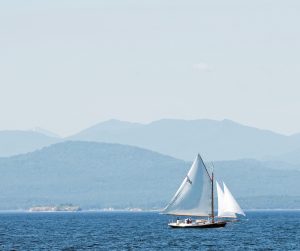
With a length of approximately 125 miles, Lake Champlain is one of the largest lakes in the Mid Atlantic region.
This unique body of water is bordered by New York, Vermont, and Quebec, Canada. The lake is fed by a number of tributaries including the Boquet, Saranac, and Ausable Rivers.
Lake Champlain fish species include landlocked Atlantic salmon, lake trout, northern pike, walleye, yellow perch, white perch, largemouth bass, smallmouth bass, black crappie, and others.
Shallow water species such as northern pike and crappie are often found along sheltered areas such as Kelley Bay, Missisquoi Bay, Dillenbeck Bay, Carry Bay, Keeler Bay, St. Albans Bay, the shallow flats south of the Sandbar Causeway.
Several of the lake’s tributary streams provide productive fisheries for salmon, trout, and other species.
Twice a year, Atlantic salmon ascend three of Lake Champlain’s tributary rivers; the Boquet, Saranac, and Ausable.
In spring, warmer water temperatures trigger the salmon to ascend the rivers for a period of about six weeks.
The main salmon run occurs in the fall when the salmon leave Lake Champlain and return to their home rivers to spawn. During the fall run, anglers target large salmon early fall into November.
During the summer, landlocked Atlantic salmon can be caught in Lake Champlain in the Inland Sea area north of the Sandbar Causeway.
After decades of restocking efforts by the Lake Champlain Fish and Wildlife Management Cooperative, lake trout have rebounded on the lake.
Lake trout are often found in deep-water areas of the lake. Productive deep-water areas are found off Grand Isle, and parts of Outer Mallets Bay, Shelburne Bay, Converse Bay, Button Bay, and near the Champlain Bridge.
Lake Champlain is one of the top areas for ice fishing in the Northeast. Yellow perch are usually the main catch, although a variety of species can be targeted.